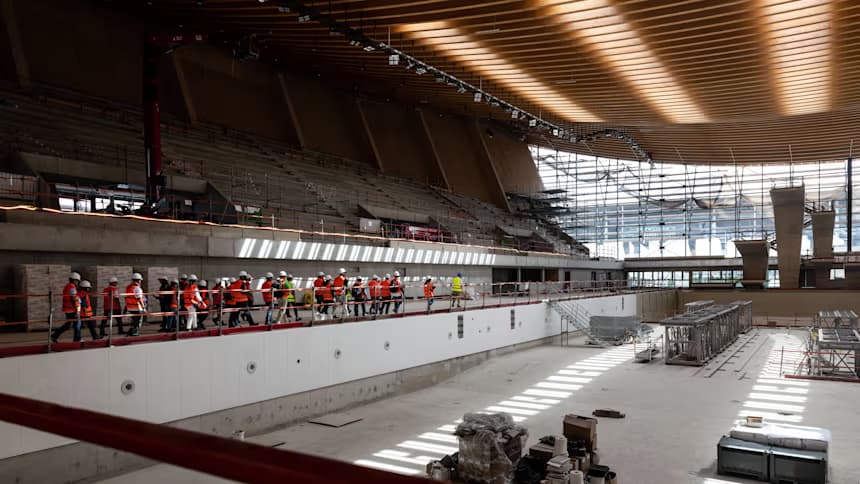The 2024 Summer Olympics in Paris are about to make a significant statement about sustainable architecture. Instead of constructing grand monuments as previously done by host cities, Paris has chosen to focus on sustainable timber structures. The city is emphasizing the growing opportunities that wood offers in various segments.
The new Olympic Aquatics Center, a 5,000-seat venue, is built mostly from wood and serves as the main architectural icon for the Summer Games. The design strives to prioritize sustainability over colossal construction.
The Olympic Village will also be an eco-quarter where all buildings under eight floors will be constructed from wood and glass. Energy will be sourced sustainably via renewables.
This eco-friendly approach extends beyond the Games, forming part of France’s broader sustainability goals. With a target to cut carbon emissions in the building sector by 55% by 2030, the country is embracing the use of wood in new construction, including innovative wood components.
The growth of the wooden construction market reflects this shift, reaching €4.6 billion last year. This marks a 14% increase since 2020.
Building with wood offers several benefits, from its natural beauty to its carbon-reducing properties. However, challenges remain, such as cost considerations, design complexity, and code limitations that prevent taller wood buildings from being created due to fire safety concerns.
Despite the hurdles, the Paris Olympics underscore the advantages of wood construction. The Grande Halle, a remarkable wooden structure near the Eiffel Tower, showcases the flexibility and sustainability of wood. With its 44 wooden arches, it eliminates the need for indoor columns. Post-Games, this temporary gallery space can be repurposed into smaller units, highlighting the essence of sustainable and reusable architecture.
Future Opportunities for Wood in Construction
The need for wood for large construction projects extends beyond the conclusion of the Olympics. In 2022, France enacted the Environmental Regulation 2020 (RE2020), a national regulation designed to enhance the environmental performance of buildings throughout their entire lifecycle. This comprehensive approach covers everything from the procurement of raw materials and construction to the usage of the facility and the building’s eventual ‘end-of-life.’
With RE2020, France is setting a global example in its approach to sustainable construction practices, requiring newly constructed buildings to adhere to stricter energy performance and greenhouse gas emission standards. This legislative initiative is pivotal as it mandates incorporating bio-based materials, such as mass-timber products, thereby creating a significant opportunity for the forestry sector.
For the forestry industry, RE2020 opens up new avenues for growth and innovation. By making the use of bio-based materials mandatory by 2025, the regulation directly stimulates demand for sustainable wood products. This could encourage the industry to expand its production capacity and invest in advanced processing technologies.
Additionally, the focus on renewable materials helps to amplify the role of forests as carbon sinks, which is beneficial for both carbon sequestration and the overall health of woodland ecosystems. RE2020 not only promotes a greener built environment but also strengthens the forestry sector’s economic and environmental contributions.
“Wood is the only structural material that meets the needs of the construction industry. It has low emissions during production and stores carbon throughout its life. It is currently essential for meeting the highest criteria of the RE2020,” stated Bastien Bouteloup, Director of R&D and Engineering at Woodeum.
Key Considerations for the Future
France’s RE2020 presents significant opportunities for the forestry industry by promoting sustainable building practices and encouraging the use of wood as a key material in construction. This aligns with broader environmental goals to reduce carbon emissions and promote renewable resources, positioning the forestry sector as a crucial player in achieving these objectives.
However, there are several questions professionals in the forestry sector need to consider when looking ahead:
- How would demand be affected by a significant shift towards using wood in construction?
- How can sustainable forestry practices be ensured to meet the rising demand for timber?
- To what degree will timber prices fluctuate with a rise in demand for construction purposes?
- What technological advancements and investments are necessary to accommodate a potential surge in demand?
- How can collaboration between government, industry, and private landowners be fostered to optimize timber production?
- What role can innovation in bio-based materials play in enhancing the structural capabilities of wood in construction projects?
Source: Paris Uses Wood for Olympic Aquatics Center: What Does This Mean for the Forestry Industry?
